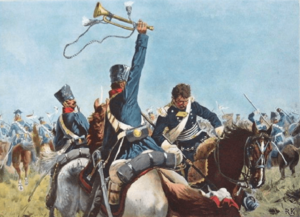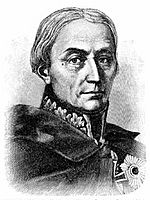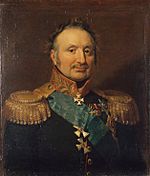Battle of Möckern facts for kids
Quick facts for kids Battle of Möckern |
|||||||
|---|---|---|---|---|---|---|---|
| Part of the German campaign of the Sixth Coalition | |||||||
 Painting of the German artist Richard Knötel (1857-1914): Battle of Möckern |
|||||||
|
|||||||
| Belligerents | |||||||
| Commanders and leaders | |||||||
| Strength | |||||||
| 50,000 | 24,000 | ||||||
| Casualties and losses | |||||||
| 2,200 | 600 | ||||||
The Battle of Möckern was an important fight during the War of the Sixth Coalition. This war was a big conflict where several European countries teamed up against Napoleon and his French Empire. The battle happened on April 5, 1813, near a town called Möckern in Prussia. It was a victory for the combined armies of Prussia and Russia. This win was a great start for the "Liberation War" which aimed to free German lands from French control.
Contents
Why the Battle Happened
After a huge defeat in Moscow in late 1812, Napoleon's power started to weaken. Prussia, which had been forced to be an ally of France, began to think about changing sides. On December 30, 1812, Prussia signed an agreement with Russia called the Convention of Tauroggen. This agreement meant they would stay neutral towards each other. Then, on March 27, 1813, both Prussia and Russia officially declared war on France.
How the Battle Unfolded
In March 1813, the Allied armies (Prussia and Russia) decided to attack French forces. These French troops were located in Magdeburg. The Allies wanted to cross the River Elbe and move further west.
- Allied Commanders: Troops were sent under the command of Prussian generals Friedrich Wilhelm von Bülow, Karl Ludwig von Borstell, Friedrich von Hünerbein, and Ludwig Yorck. Russian commanders included Peter Wittgenstein and Friedrich Wilhelm von Berg. General Wittgenstein was in charge of all Allied operations.
- French Movements: The French learned about the Allied plan. Around 30,000 French soldiers, led by Viceroy Eugène, left Magdeburg on April 2, 1813. They crossed the Elbe River and set up their main camp in Königsborn.
- Wittgenstein's Plan: General Wittgenstein planned to trick the French. He wanted to make them move east, then cut off their return path to Magdeburg.
- Positions: The French positioned their troops along the Ehle River, between Möckern and Gommern. The Allies had about 10,000 men. They marched in from the northeast, east, and southeast in three groups.
- Early Clashes: Small fights happened on April 3rd and 4th. The French did not use many troops in these early skirmishes. Messages started to arrive saying that the French wanted to go back to Magdeburg. Because of this, Wittgenstein gave the order to attack on April 5th.
Key Moments of the Fight
- Fighting at Dannigkow: General Hünerbein's troops, coming from the south, met the French near Dannigkow. The French fought very hard, leading to intense house-to-house fighting. Even though Hünerbein's forces were outnumbered, they managed to push about 2,000 French soldiers out of their positions after four hours.
- Battle at Vehlitz: The second major clash took place at the Ehle River crossing in Vehlitz. Prussian and Russian troops, led by Borstel and Berg, attacked the French. The French had set up several lines of defense along the Ehle and behind Vehlitz. It was hard for the Allied cannons to fire effectively because of the steep ground. The battle turned into close, hand-to-hand combat. A wide, swampy area between the two armies made fighting even harder. Soldiers had to wade through water that was sometimes chest-high. Despite these difficulties, and even with French cavalry attacks, the Allies successfully forced the French out of their positions here too.
What Happened Next?
Because of these unexpected defeats, the French viceroy, Eugène, decided to pull his troops back to Magdeburg on the night of April 5th. As they retreated, the French destroyed all the bridges of the Klusdammes. This stopped the Allies from easily reaching Magdeburg.
Even though this battle did not completely defeat the French forces in Germany, it was a very important first success for the Prussians and Russians. It was a big step towards their final victory over Napoleon.
Images for kids





